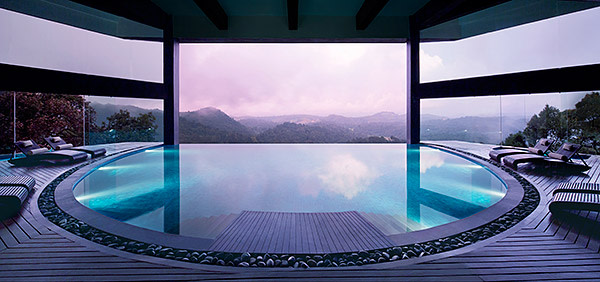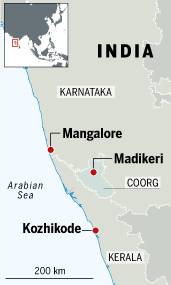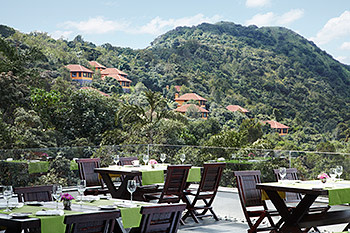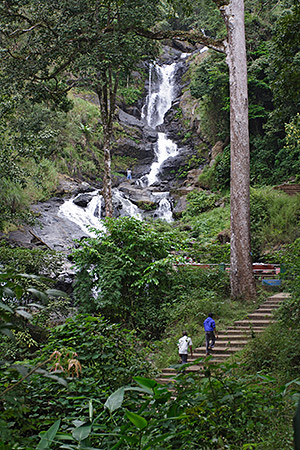Walking and wildlife in Coorg, India

Simply sign up to the Life & Arts myFT Digest -- delivered directly to your inbox.
For one fanciful moment, I am an eagle hovering on a warm current above a plunging valley, nothing beneath me but air. On the slopes below, a few glimpses of ochre and a metallic gleam; far down in the base of the valley, a patch of intense green with a moment’s white flash, a silvery glimmer of water, a ribbon of narrow track along which an antlike human, minuscule at this distance, crawls towards a cluster of low roofs.
And beyond, to every side, a perfect rounded amphitheatre of hills, lushly wooded, rolling back and back like a repeating pattern to the milky horizon countless miles away.
This is India, but no India I have ever seen before. These hills are in Coorg (or Kodagu), a district of Karnataka, part of the Western Ghats, which run for almost 1,000 miles through four states and down the flank of southern India. Warm, lush and wet, they are home to such a range of wildlife that they are one of Unesco’s world heritage and special biodiversity sites.
Although it is less well-known to the foreign visitors who flock to neighbouring Kerala and Goa, or to the game parks and cultural sites elsewhere in the state, wealthy Indian tourists describe Coorg as one of the country’s exciting new destinations. If the idea of three and a half months of summer rainfall dampens the enthusiasm of some northern Europeans, for visitors escaping the furnaces of India’s northern cities it can be a draw: one Delhi resident told me he sometimes travels south in summer just “to watch the rain come down”.

By December, though, the climate is balmy-perfect: ideal for walking, watching wildlife or just lounging. There are apparently 508 bird species in the Western Ghats, 300 of them in Coorg alone but I, sadly, haven’t turned into one of them. In my eagle-moment I was in fact warmly buoyed up in an infinity pool perched high on the hillside, my elbows splayed on the rim, my chin on my hands, gazing out over the vast view as the light thickened to steely-grey and the setting sun began to throw out a few fierce parting flashes of angry orange.
That pool is just one arena of high drama in this highly dramatic building, the Vivanta by Taj hotel in Madikeri, which opened a few months ago. The first approach is deceptive: you arrive at a simple enough structure with the pitched and tiled roof typical of the locality, and built with the summer rains in mind. But that’s where the understatement ends. Walking into this airy lobby is a high-voltage charge: the “wall” opposite is another open infinity space, a terrace edged only by a warning strip of water, perched over the same vertiginous view of valley and mountains.
This is actually the top storey of a six-layered structure that steps down the mountainside – the infinity pool is on the fourth floor down. And those eagle-eye glimpses down the valley? The ochre patches just visible through thick trees are the walls of the individual cottages that house the hotel’s 62 beds, painted with pigment from the local earth, each a pod-like indoor-outdoor world within the forest. Some of the grander “cottages” are true fantasies: try a pillared living space like a Roman bath, with internal pool.
There’s more. That silvery water I could see from the roofed upper pool is the large outdoor pool far below, where an open-air dinner lit by 101 candles can be magicked into being; the village-like cluster is a “presidential suite”, isolated enough for the most reclusive celebrity. That flash of intense green is a paddy field on the valley floor, with fluttering egrets – do they know they are set-dressing for this theatrical creation? Separate buildings up and down the hill house a bar and a restaurant/kitchen block (with more startling terrace views).

It’s not so much a hotel as a settlement. Every bit of it is high-designed, rather masculine luxury, sleek and a little severe. Local black granite and river pebbles, fierce dark hardwoods from the area, brick made on-site by an ecologically friendly process of compression …the attention to detail in these buildings is as startling as the natural setting.
And the author of all this? Owner, designer, architect Pramod Ranjan, who spent many years in Australia before returning to live in Chennai some eight years ago, created this place and dreamt up every detail, down to the design of the hardwood loungers in the sleekly aesthetic spa. The Taj group may manage this property but they couldn’t keep him away, even if they wanted to: he is its passionate driving spirit, showing guests round with fierce quiet pride, organising and chivvying, a beady eye everywhere, sending staff scurrying with a raised eyebrow.
Searching for a site for Ranjan’s creation was itself an Indiana Jones-style mission, as he tells it – exploring forest tracks in a bumping jeep, tramping ankle-deep through undergrowth and streams. Then, once he had acquired (as he modestly put it, with a wave of the hand at the surrounding bowl of mountains) “everything you can see”, a seven-year marathon of building work began. With his belief in ecological care and minimal intervention, he clearly did everything the hard way – but it has paid off in an environment which cannot be anything but the fruit of one man’s passion.
Getting there, however, is not for the faint-hearted. Our drive from Bangalore took six hair-raising hours: Mysore is an hour or so closer (depending on how much you value your life). The town of Madikeri is not on the doorstep either: once at the Vivanta, you are not going to pop out for dinner.
Luckily, executive chef Easo Johnson presides over a kitchen whose produce you wouldn’t want to miss. Since he is not from Coorg himself, he has researched its local cuisine in houses great and small. There are few vegetarians here, and pork (especially the wild boar from the hills) is a speciality. This is rice country and there’s little wheat: rotis are rice flour, and accompany mouthwatering combinations of fish and fruit (coconut, lime, bamboo), as well as succulent mutton and intricately spiced sauces.
And all that biodiversity? Well, tell me that there are 300 species of birds in these hills and my eyes glaze over; show me one nilgiri blue robin and I will be happy all day. Or tell me about how the king cobras make a 6ft-high nest of leaves, in which the gradually decomposing vegetation keeps the female at the right temperature as she lies curled around her eggs – as our guide told us on one walk – and I’m very content.

The walking is lovely – but I have one beef. You can’t go alone. As delightful and full of cobra-knowledge as the guides are, for me walking should be serendipitous and sometimes solitary. That is firmly discouraged here – no doubt for proper reasons of safety, but nonetheless it made me feel a little cooped up. One trail, up a neighbouring valley, was closed because “the elephants visit us quite often”. Foreign visitors are madly eager to encounter a wild elephant; our Indian hosts were just as anxious to keep us well away from them. It’s understandable, if frustrating.
Elsewhere in Coorg, the elephants have to be accommodated too. The coffee plantations that grow the district’s most notable product cover miles of rolling hills, and are fenced with strong electric charges to deter them – but all they do is pick up a handy tree trunk and chuck it on to the wire, which shorts the current for long enough for them to march through in their stately processions, led by a matriarch whose canny wisdom has everyone in awe.
“She is so clever – so clever!” enthused our guide at the Cottabetta plantation, about 10 miles southwest of Madikeri. He grew up here, son of coffee pickers, but now farms tourists eager to share his encyclopedic knowledge of the forest and its birds and animals (even the brilliantly coloured spiders are spectacular).
This is all part of the Plantation Experience, run by the mighty Tata corporation, which owns Taj hotels and (it feels like) roughly three-quarters of all India. From coffee seed to instant powder, it’s Tata. As are the vehicles we drive in, the road-making equipment that makes the tracks, the clinics and schools for the workers and the steel that makes their girders: the same group, incidentally, is the biggest single corporation in the UK.
But here in the misty hills it’s a small-scale “experience” on offer by Tata Coffee. The colonial plantation bungalows built some 70-80 years ago are now (lightly) converted for holiday stays: complete with old-style furniture, lazily circling ceiling fans, high windows and old-school bathroom taps, they’re a long way from slick, modern design: a sort of dream of yesteryear, made comfortable.
I was entranced by the deep shady coffee plantations, stretching for hundreds of acres up and down the steep hills. Coffee grows at high altitude on bushes that look a bit like rhododendrons, pruned low for ease of picking the berries. They flourish in the dappled shade of tall trees, deliberately kept thin, up each of which grows a vinelike tangle that turns out to be pepper. It’s a pleasingly sustainable farming method that looks mistily wild and dreamy, with its fierce birdcalls and its woody depths.
But once again, all you can do is look at it from a jeep. You can’t walk alone or explore. It’s the Indian way, like it or lump it. And those elephants? Meeting one of them by chance, our guide told me, is the plantation workers’ worst nightmare. Ah well.
On the way to Coorg, there’s the Taj West End in Bangalore: lush tropical gardens around delightfully old-school blocks of rooms that remind you of all those Passage to India-type films – that’s because many of them were shot there. There’s a special historical photograph gallery, including a picture of one resident who stayed for 37 years. I couldn’t blame him.
Many Taj hotels have speciality restaurants: the Taj Mahal Palace in Mumbai has its Middle Eastern Souk; the Taj Land’s End, in west Mumbai, has a delicious outpost of London’s San Lorenzo; the Taj West End has India’s first Vietnamese restaurant.
Personally, I go to India to eat Indian food, preferably in the street – but Italian cooking is India’s most popular foreign cuisine, with pizza, pastas and tricolore salads high on the menus. When it comes to fusion fun, though, the Taj West End’s latest rates a warm mention: Indian high tea. At le fife-o’clogue, as the French used to say, you can be served a traditional three-tiered silver cakestand piled with carefully adapted Indian delicacies – tiny spicy parathas, intensely sweet fruity cookies. All, of course, with an extensive menu of teas.
Jan Dalley is the FT’s arts editor
——————————————-
Jan Dalley was a guest of Cox & Kings (coxandkings.co.uk) which offers an eight-night trip to India from £1,285 – including domestic flights, private transfers, plantation and birdwatching tour. For details of the Taj hotels see tajhotels.com. Flights from London with British Airways (ba.com) start from £590 return
Comments